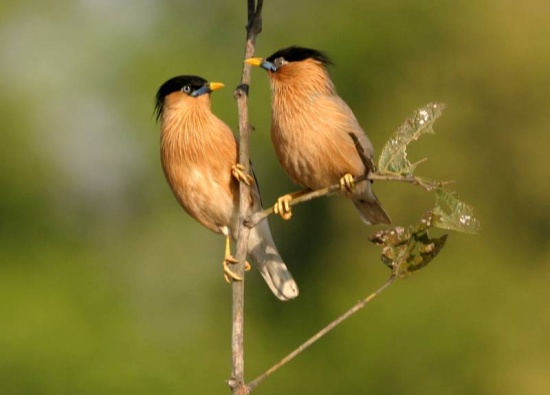(update link) |
(References updated. Video link) |
||
| Line 1: | Line 1: | ||
| + | '''Alternative names: Black-headed Mynah; Pagoda Myna''' | ||
[[Image:Brahminy_Starling.jpg|thumb|550px|right|Photo by {{user|obasanmi|obasanmi}}<br />Bandhavgarh, [[India]], March 2005]] | [[Image:Brahminy_Starling.jpg|thumb|550px|right|Photo by {{user|obasanmi|obasanmi}}<br />Bandhavgarh, [[India]], March 2005]] | ||
| − | + | ||
;[[: Category:Sturnus|Sturnus]] pagodarum | ;[[: Category:Sturnus|Sturnus]] pagodarum | ||
''Temenuchus pagodarum, Sturnia pagodarum'' | ''Temenuchus pagodarum, Sturnia pagodarum'' | ||
==Identification== | ==Identification== | ||
| − | 20cm. A small starling with a long wispy crest. | + | 20cm (7¾ in). A small starling with a long wispy crest. |
* Grey upperparts | * Grey upperparts | ||
* Reddish-orange underparts | * Reddish-orange underparts | ||
| Line 10: | Line 11: | ||
* White outertail, prominent in flight | * White outertail, prominent in flight | ||
* Yellow wattles, bill (with bright blue base) and legs<br /> | * Yellow wattles, bill (with bright blue base) and legs<br /> | ||
| − | [[Image:Brahminy Myna juvenile157.jpg|thumb| | + | [[Image:Brahminy Myna juvenile157.jpg|thumb|300px|right|Juvenile<br />Photo by {{user|Ains|Ains}}<br />Mount Abu, Rajasthan, [[India]], July 2010]] |
Sexes similar, males have a longer and blacker crest. Juveniles are much duller, have a sooty-brown head and lack the crest. | Sexes similar, males have a longer and blacker crest. Juveniles are much duller, have a sooty-brown head and lack the crest. | ||
==Distribution== | ==Distribution== | ||
| Line 31: | Line 32: | ||
Mainly resident, birds from the northern part of the range (Afghanistan, Kashmir) migrate south. | Mainly resident, birds from the northern part of the range (Afghanistan, Kashmir) migrate south. | ||
==References== | ==References== | ||
| − | #{{Ref- | + | #{{Ref-Clements6thAug14}}#{{Ref-HBWVol14}}#AvianWeb |
{{ref}} | {{ref}} | ||
==External Links== | ==External Links== | ||
{{GSearch|Starling+pagodarum}} | {{GSearch|Starling+pagodarum}} | ||
| + | <br /> | ||
| + | {{Video|Brahminy_Starling}} | ||
| − | [[Category:Birds]][[Category:Sturnus]] [[Category:Sturnia]] [[Category:Temenuchus]] | + | [[Category:Birds]][[Category:Sturnus]] [[Category:Sturnia]] [[Category:Temenuchus]] [[Category:Videos]] |
Revision as of 21:23, 5 August 2015
Alternative names: Black-headed Mynah; Pagoda Myna
- Sturnus pagodarum
Temenuchus pagodarum, Sturnia pagodarum
Identification
20cm (7¾ in). A small starling with a long wispy crest.
- Grey upperparts
- Reddish-orange underparts
- Black crown, nape and crest
- White outertail, prominent in flight
- Yellow wattles, bill (with bright blue base) and legs
Sexes similar, males have a longer and blacker crest. Juveniles are much duller, have a sooty-brown head and lack the crest.
Distribution
Asia: found from northeast Afghanistan east over Pakistan, India to southern Nepal and rarely in Bangladesh. Non-breeding visitors in Sri Lanka.
Vagrants recorded in northeast India, Burma, Thailand, Singapore and China but these may also be escaped cagebirds.
Common in most of its range.
Taxonomy
This is a monotypic species[1] which is sometimes placed in the genus Temenuchus or alternatively in Sturnia.
Habitat
Dry forest, jungle and scrub. Also visits gardens. Prefers waterlogged areas. Found in lowlands and hills up to 1800m.
Behaviour
Diet
Feeds on insects, other invertebrates, fruit, berries, flowers and nectar.
Forages on the ground, often walking among cattle. Associates often with other species like Chestnut-tailed Starling, Asian Pied Starling, Common Myna or Jungle Myna.
Breeding
Breeding season mainly April to August. A monogamous, usually solitary species, sometimes in loose colonies. It nests in holes and 3-5 eggs are laid.
Movements
Mainly resident, birds from the northern part of the range (Afghanistan, Kashmir) migrate south.
References
- Clements, J. F., T. S. Schulenberg, M. J. Iliff, D. Roberson, T. A. Fredericks, B. L. Sullivan, and C. L. Wood. 2014. The eBird/Clements checklist of birds of the world: Version 6.9., with updates to August 2014. Downloaded from http://www.birds.cornell.edu/clementschecklist/download/
- Del Hoyo, J, A Elliott, and D Christie, eds. 2009. Handbook of the Birds of the World. Volume 14: Bush-shrikes to Old World Sparrows. Barcelona: Lynx Edicions. ISBN 978-8496553507
- AvianWeb
Recommended Citation
- BirdForum Opus contributors. (2024) Brahminy Starling. In: BirdForum, the forum for wild birds and birding. Retrieved 15 June 2024 from https://www.birdforum.net/opus/Brahminy_Starling
External Links





